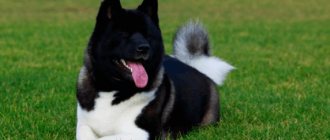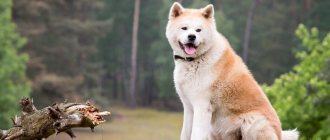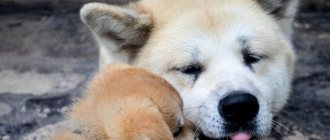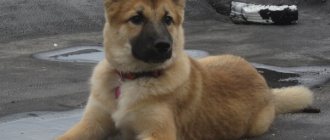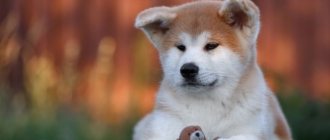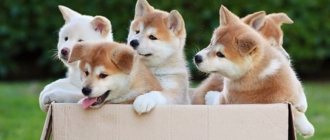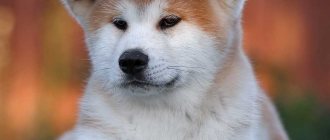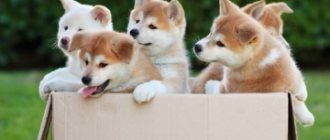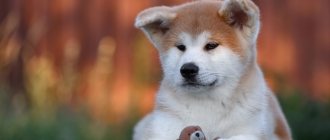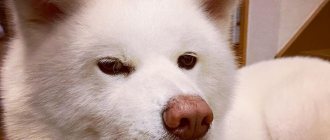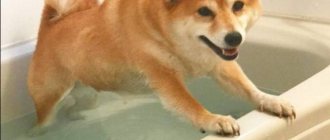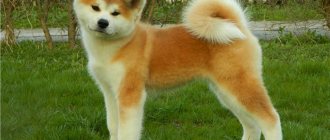Akita Inu is a dog breed recognized as a national treasure of Japan. The character of these large Spitz-shaped dogs harmoniously combines seemingly mutually exclusive qualities: good nature and alertness, courage and obedience. Over the centuries, they have proven themselves as universal hunters and reliable guards. In the modern world, they have become full-fledged members of families and reliable companions for their owners.
History of the breed
Akita Inu is one of the most famous Japanese Spitz dogs. It is one of the 14 most ancient dog breeds on earth. This version is confirmed by the results of archaeological research. DNA analysis showed the similarity of the Japanese Akita genotype with the genotype of wolves.
The homeland of this dog breed is considered to be the northern province of Hanshu Island, Akita Prefecture, a rugged mountainous region with a harsh climate. Winters there are cold and snowy. Large Spitz dogs were used to hunt bears, deer, and wild boars. As a rule, dogs worked in pairs - a male and a female. They drove the ferocious animals and held them until the hunters arrived. People in those days especially needed four-legged reliable helpers. In those days they were armed with bows and arrows. Any mistake during the hunt could lead to unpredictable consequences. It was reliable hunting dogs that protected people from the rage and revenge of wounded or enraged wild animals.
Local huskies already in those days established themselves as universal dogs. They moved silently and quickly. We moved well in deep snow. They had a keen sense of smell and a keen eye. They were distinguished by their endurance, intelligence and fearlessness in the hunt.
Initially, the dog was called “Matagi-ken”, then “Matagi-inu”. The ancient Japanese word "matagi" translates to "respected hunter." This is how in those days it was customary to address people who were considered the most successful hunters. This appeal was enshrined in the original name of the breed - “respected hunter dog.”
Initially, dogs stood out for their high intelligence and desire to help people. Red Spitz have proven themselves to be versatile dogs. There is evidence that indicates that these dogs helped fishermen drive fish into nets.
Documents show that already in the 6th century, clubs for breed lovers were founded in Japan. Dog handlers of that time developed recommendations that helped breed, maintain and train dogs. In the 15th century, special stud books were established. Pedigrees of dogs with nicknames and descriptions were carefully entered into them.
Experts attribute the final formation of the breed to the beginning of the 17th century. Kuge, who received the position of ruler of Akita Prefecture, was fond of hunting and dogs. He ordered his subjects to breed a new breed of large and intelligent hunting dogs. Set short deadlines. The breeders got to work. The blood of mastiffs and Tosa Inu was added to the local Spitz dogs. As a result of breeding work, the dog lost its Spitz features. But its representatives were superior to other local dogs in their large size and harmonious build. They stood out for their fearless character. At the same time, they retained excellent hunting qualities.
A new name was assigned to the dogs - Akita Inu. It is simply translated - “dogs from Akita Prefecture.”
Initially, these dogs were not available to ordinary people. Only aristocrats and members of the imperial family could own them. Dogs from Akita Prefecture, along with excellent hunting talents, showed remarkable guarding abilities. They reliably protected the palaces and houses of their owners.
Each dog was looked after by a separate servant dressed in a special expensive suit. The servant's clothing was supposed to emphasize the respect that the Akita Inu enjoyed. There were special ceremonies that were performed by staff when feeding and caring for the animal.
Special ammunition was made for the Inu. It was supposed to emphasize the rank of the dog and the social position of its owner.
From the Middle Ages until the beginning of the 20th century, one of the favorite entertainments of people in many countries of the world was dog fighting. It gained popularity in Japan in the 19th century. Akita Inu took part in them. It was only in 1908 that this bloody entertainment was banned in Japan. At that time, many experts assumed that this would lead to a decline in people’s interest in cynology and to the extinction of popular dog breeds, including the Akita Inu. They turned out to be wrong. Interest in the breed has not disappeared. It was preserved and developed. In 1931, in the land of the rising sun, the Akita Inu dog breed was recognized as a national treasure. From that moment on, the dogs were under state protection. It was prohibited to export them outside of Japan.
The situation changed during the Second World War. There was not enough food for the people. There was nothing to feed the dogs. German shepherds turned out to be more in demand in the country. They were used for the needs of the army. Breeders began mixing Akitas with representatives of this breed. Purebred Akitas were considered less valuable. Their skins were used to make warm clothes and shoes for military personnel.
At this time, a rabies epidemic broke out in the country. To protect people, a decision was made at the state level to exterminate all dogs that were not used by the army. As a result, only a few purebred representatives of the breed survived. Devoted followers of the breed smuggled them into mountainous, inaccessible areas of the country. This is the only way they have been preserved.
By the middle of the 20th century in Japan, all representatives of the breed could be divided into three types:
- hunting;
- fighting;
- service or mixed with a German Shepherd.
Japanese breeders have once again done a tremendous job to restore the breed.
At the same time, several purebred dogs were exported to the United States. American breeders used them as breeding material to breed the American type of Akita Inu. Subsequently, it was recognized as a separate breed, which was called the "large Japanese dog."
History of the origin of the American Akita
The country of origin of the breed is recognized as the USA, and the ancestor is the Japanese Akita Inu. The unusual journey of an aboriginal dog from the eastern islands to the New World was accompanied by many complex and interesting facts:
- Danger of degeneration. Before the arrival of the Americans, the Japanese risked losing their four-legged national treasure several times: the first time due to crossing with foreign dogs. The second time, most of the individuals died during the fighting of 1941-1945.
- Meeting the American military. Returning to their homeland, the Americans took with them several Japanese puppies.
- The emergence of a new breed. After the arrival of the unusual dogs, American breeders began breeding them without relying on Japanese standards. The grown-up puppies were dubbed large Japanese dogs, and their offspring - American Akita.
The Japanese did not accept the new breed for a long time and tried to win the right to a common pedigree, but their efforts were in vain. Over the years, the American Akita began to differ from its closest relative not only in appearance, but also in behavioral characteristics.
Americans achieved international recognition and an official breed standard only at the beginning of the 21st century.
Hachiko's story. Fiction or truth
The whole world learned about who Hachiko was thanks to cinema. People cried when watching films about a faithful dog. Two of them were filmed. In 1987, the Japanese film The Story of Hachiko was released. In 2000, the Americans filmed a remake of it, “Hachiko: The Most Faithful Friend.” The role of the professor in it was played by Richard Gere. It was the second option that most Russians looked at. People were not only touched by the tragic fate of the Akita Inu, they wanted to know the true story of the legendary dog. In the American version, events developed in the USA. The story actually took place in Japan in Akita Prefecture.
The real Hachiko was born on November 10, 1923. He was the eighth dog in the life of the Japanese scientist Hidesaburo Ueno. That's why he named his pet Hachiko. Translated from Japanese as “eighth”. There is another meaning for this word - “devotion”. Some experts argue that the nickname given to an animal affects its fate. Not everyone agrees with this statement. However, the fate of Hachiko is a clear confirmation of this.
The dog has grown up. Every morning he accompanied his master to Shibuya Station, from where he left for work in Tokyo. Hidesaburo Ueno taught at the capital's university. The dog was returning home. By three o'clock in the afternoon I returned to the station again. I met the professor.
On May 21, 1925, the irreparable happened. At work, during a lecture, the professor had a stroke. Those around him were unable to provide him with the necessary help. Ueno died.
At that time, Hachiko was one and a half years old. That day, as usual, he arrived at the station at three o'clock in the afternoon. I waited until evening. To no avail.
The next day, at three o'clock in the afternoon, the dog again came to meet the train. History repeated itself day after day. Hachiko did not lose hope. He hoped that his loving owner would return one day. The dog spent the night on the porch of the owner's house. Relatives and friends tried to take the dog home. The dog didn't want this. At the first opportunity, I ran away from them and returned to the station. Local merchants and railroad workers fed him out of pity. So seven years passed.
One of the professor's students wrote an article about an old and faithful Akita Inu, who has been waiting for many years for the return of his deceased owner, and published it in a major Tokyo newspaper. The story shocked Japan.
People flocked to Shibuya Station, where the events unfolded. They came only to see the devoted dog with their own eyes. Some dreamed of taking Hachiko with them. However, they failed to do this. The dog did not pay attention to them, did not make contact, did not accept the affection of strangers, and continued to live according to his own schedule.
The loyalty and devotion that the dog kept towards the deceased person aroused respect and admiration. People decided to erect a monument to the legendary Akito Inu. The opening ceremony took place on April 21, 1934. At that time, Hachiko was still alive. According to eyewitnesses, the dog himself was present at the event and indifferently contemplated what was happening.
In 1935, Hachiko died. It happened on the street adjacent to the station. As an autopsy later showed, the cause of death was heart disease, which had begun to progress to cancer. By that time, the dog had already become a four-legged hero throughout the country. National mourning was declared over his death.
Some of the remains of the faithful dog are buried in Tokyo's Aoyama Cemetery, the other is stuffed in the capital's Science Museum.
During the Second World War, the monument to the faithful Akita Inu was dismantled for military purposes. The country needed metal. After the war, in August 1948, it was restored at the request of the people.
Flowers are brought to the statue of the legendary dog, located on the pedestal. Lovers make dates near her. Tourists take pictures. For the Japanese, the Akito Inu Hachiko remains a symbol of fidelity and love.
In 2015, a second monument to the legendary dog was opened at the University of Tokyo. Its official name is “Statue of Hachiko and Dr. Hidesaburo Ueno.” However, residents of the capital call it differently - reunion.
The sculptor captured the moment Hachiko met her owner. Hachiko dreamed about this event for nine long years. I didn’t wait in my lifetime. People have united a faithful dog and its owner in bronze.
Interesting Facts
In its homeland, the Akita is a cult dog. She is considered an excellent companion, protector of the home, and a symbol of good health. There is a tradition, when a child is born in a family, to give the parents a figurine of an Akita. Such a gift symbolizes the wish of happiness, health and longevity. A person receives the same souvenir if he is very sick. Friends and relatives express their support for him in this way and wish him a speedy recovery.
The Japanese Akita is one of the world's most popular dog breeds used as companions. She competes with Labradors for the title of “best companion.” In the USA, these balanced, friendly dogs are specially trained and used in medical centers for the rehabilitation of people who have suffered serious illnesses or are struggling with serious illnesses. Akitas provide convalescents with emotional support in the fight against the disease. They are used for the same purpose in nursing homes.
If you look at an Akita Inu, the dog may appear to be smiling. The point is the special structure of the jaws.
On the Akita's paws, the toes are pressed tightly together. It's like they grow together. Due to this, it seems that they are connected by membranes. The special structure of the paw allows the dog to correctly distribute its weight so that it can easily move through the snow. For the same reason, Japanese dogs feel great in water - they swim well.
In 1977, the Akita Inu Museum was established in Odate, Japan. The exhibits presented there tell the history of the breed. The office of the Society for the Protection and Preservation of Akita Inu is located in the same city. This organization annually holds breed championships and selects the best representatives.
In 2012, Akita Prefecture Governor Norihisa Satake presented an Akita Inu puppy to Russian President Vladimir Putin. The gift was presented as a token of gratitude for Russian assistance in eliminating the consequences of the 2011 earthquake. The puppy was given the name Yume. Translated from Japanese into Russian as “dream”.
Key facts
Akita is an excellent guard and loyal friend. The price for a purebred puppy starts from 15 thousand rubles. The description of the American Akita breed emphasizes that the dog is somewhat larger than its purely Asian brother and progenitor - the Akita Inu.
The abbreviated name of the breed comes from the Japanese prefecture of Akita, but the official country of origin is the United States. Another name for the breed is “large Japanese dog,” emphasizing the large size of the animal:
- height at withers – 61-71 cm;
- The weight of the American Akita is 32-65 kg.
The maximum height and weight indicators are typical for males, the minimum - for females. In addition to the difference in size of the American Akita, males are distinguished by a more obstinate and pugnacious disposition. Females have a softer character, so they are well suited for owners with little experience. Individuals that are too aggressive or cowardly are rejected from breeding.
On average, a dog lives 12 years, and the maximum life expectancy of an American Akita with proper maintenance and care is 14 years.
When choosing a nickname, it is recommended to start from the characteristics of the American Akita breed. The English and Japanese versions sound equally good, especially if you put some meaning into them.
Description of the Akita Inu dog breed
Japanese dogs stand out for their exquisite appearance and proud posture. The appearance evokes involuntary respect. The physique is dense and proportional. The backbone is strong. The Akita Inu is distinguished from other Spitz-type dogs by its high stature. The height at the withers for males is 64-70 cm, for females - 58-64 cm. The weight of Akita Inu ranges from 30-45 kg. Boys are bigger.
Head
Large. The skull is voluminous with a wide forehead. The median groove is clearly defined. The transition from forehead to muzzle is pronounced. The bridge of the nose is short and straight. The muzzle is pointed and strong. The cheeks are muscular. Lips are dry and tight-fitting. The nose is large and black. In light dogs it may be pink.
Eyes
Almost triangular in shape. Small ones. Dark brown.
Ears
Triangular in shape with slightly rounded ends. Small and fat. Akita Inu keep them raised up and slightly tilted forward.
Frame
Extended format. Thick, muscular neck without dewlap. Deep chest. Ribs moderately sprung. The back is straight and strong. The loin is wide and muscular. The stomach is strongly tucked.
Limbs
The Japanese Akita dog has a massive bone structure. She has large paws with tightly closed toes. The pads on them are hard and ribbed.
Tail
Thick and dense. Covered with thick hair. When straightened, it reaches the hock joints. The dog holds it thrown over his back in the form of a ring.
Wool
Consists of straight, hard guard hair and thick, soft undercoat. On the withers, croup, and “pants” - longer. But the longest is on the tail.
Color
Red, sesame or pale yellow, brindle and white. All colors, except white, must have lightened edges located on the sides of the muzzle, on the cheekbones, lower jaw, neck, chest, belly, inner surface of the limbs and tail.
Akita Inu is the largest representative of the Spitz-type dogs. Outwardly, she looks like a husky. Although almost twice their size. At the same time, it has a more balanced character. Despite these differences, the Akita is often called the “Japanese Husky.”
A smaller copy of the Akita Inu are representatives of another Japanese breed - the Shiba Inu. They are a real find for Hachiko fans who, for various reasons, cannot afford a large dog.
Description of the American Akita breed
Popularity 12th among 263 dog breeds
Lifespan:
10-14 years
Height:
males: 65-70 cm, females: 60-65 cm
Country of origin:
Japan, USA
Average price:
20-30 thousand rubles
Weight:
32-59 kg
Latest articles Cat health
Ataxia in cats: what is it, how does it manifest and is treated 01/23/2022 187 0 0
Cat health
Leukemia, or viral leukemia in cats 01/23/2022 162 0 0
Akita character
Friendly, energetic, cheerful dog with high intelligence.
Brave. He has an independent and proud character. Always ready to fight for leadership and championship. In the family he strives to take a dominant position.
An Akita dog is understanding and pleasant in communication with its owner if there is mutual understanding. If it is not there, the pets begin to show stubbornness and disobedience.
The Japanese Husky is unobtrusive and delicate by nature. It will never bother the owner if he is busy with business. On a day off, he won’t get him out of bed early in the morning. He will wait until he wakes up and is free. At the same time, she always tries to stay close to him.
Although the appearance of the Akita suggests that he does not care about the opinions of others, this is not the case. Needs emotional contact with the owner. If he doesn't pay enough attention, he may get offended.
Akita loves all family members. Treats their relatives and friends well. Enjoys communicating with people. But on one condition. Respect must be mutual. People should reciprocate his feelings.
He is wary of strangers. Always vigilant. If a stranger seems suspicious, he will not immediately attack him. It will make a menacing roar. Will try to scare away the attacker.
The Japanese Spitz is the type of guard who easily lets a thief into the house, but will never let him back out before the owners arrive.
When describing the character of the Akita Inu, experts often use the epithet “loyal.” In ancient times, Japanese mothers, when leaving home, left their children in the care of Akita Inu dogs. Despite his restraint in expressing his feelings, the dog is loyal to his owner and family. He will always stand to the last, protecting his loved ones.
Akita Inu is a one-owner dog. When for some reason an adult dog is given to a new family, it takes a long time for him to get used to the new owner. And such an “experiment” does not always end in success. Often these dogs simply run away. Therefore, before you take such a puppy into your home, soberly assess your capabilities.
Barks rarely and only if there is a reason. However, these dogs can be called talkative. They express their emotions with special grumbling, snorting and howling.
Akita dogs are not always aware of the dangers of heights. They may jump out the window or from the balcony if they see something interesting on the street.
Character of the American Akita
In order to understand how the American Akita differs from the Japanese Akita, you first need to look at their similar features:
- Devotion. The dog does not choose a favorite and gets along well with children. The “American” will never give his owner offense and will steadfastly endure any childish pranks. An Akita can injure very young children by accident, not calculating its size during play. For the safety of the child, do not leave him and his four-legged “nanny” at home unattended.
- Love of freedom and independence. Even a small puppy will not be overly intrusive. If we are talking about who this breed is suitable for, then first of all we should mention workaholics. Immediately after purchase, a puppy missing its mother may become restless. Adult dogs are more psychologically stable and will easily find something to do.
- High intelligence. Akitas have a very good memory. If you have such a smart pet, do not forget about honesty in relationships. Any deception will negatively affect trust.
Unlike Japanese dogs, the character of the American Akita is more peaceful. They get along more easily with other pets and are less pugnacious. Despite this, it is better to keep your pet (especially a male dog) on a short leash when outdoors to avoid a possible fight.
When kept in an apartment, an Akita will not disturb neighbors with its barking. Representatives of the breed have a developed guard instinct, so at home they zealously defend their territory. A sudden burst of barking is a signal indicating danger.
Living with an “American” in a big city will not cause problems for others, but it can negatively affect the dog’s health. Freedom of movement is important for the Akita, so it is more comfortable for her to walk in a suburban area. Thanks to its thick undercoat, the dog can easily live outside in winter, but being kept on a chain will be perceived as an insult.
Care and maintenance
You can keep an Akita Inu both in a private house and in a city apartment. Representatives of this breed are perfectly adapted to the Russian climate.
The Akita Inu is not a breed that can be kept on a leash. High intelligence and affection for the owner, the need to communicate with him, makes this breed unsuitable for such use.
Dogs will feel good if they have an outlet for their energy. And the Akita has a lot of it.
Japanese Huskies do not need any special long walks. You need to walk with adult dogs 2 times a day for a total of 2-3 hours. Ideally, a walk includes not only walking on a leash, but also elements of training and playing with the owner.
The Akita's coat is plush and soft to the touch and does not require much grooming. During the shedding period, which happens 2 times a year, the dog must be combed daily. The rest of the time, 3–4 procedures per week are sufficient.
The Japanese dog is very clean. Always looks neat. However, it still needs water treatments. You can wash it as needed. If the dog lives on the street, then the number of baths should be reduced to 3-4 times a year. Dogs' skin secretes a special fatty lubricant that protects animals from the cold. If it is constantly washed off, the dog will be susceptible to colds.
It is necessary to regularly examine your pet's ears and eyes. If dirt and sulfur have accumulated, or discharge has appeared, it must be removed with a swab moistened with a special solution. If signs of inflammation appear, you should contact your veterinarian.
It is necessary to check your dog's nails regularly. They usually wear themselves down. But if this does not happen, they should be trimmed with a nail clipper. If this is not done in time, the dog may get a paw injury during a walk or during games.
Feeding
A dog of Japanese origin can be fed industrial food or natural food. What is best for the pet is decided by the owner.
Whatever diet you choose, you need to be aware of the characteristics of the breed. Akita Ina is a Japanese dog. In her homeland, it is customary to eat fish, seafood, and rice. People eat these products. They are also given to dogs.
It is advisable to introduce sea fish into your dog’s diet at least 2 times a week. It could be pink salmon, pollock, hake. You should first remove the bones to prevent your pet from choking on them. To exclude the possibility of infecting your pet with helminths, it should not be given raw. Many owners pour boiling water over deboned fish carcasses; when they have cooled, they give them to the dog.
A serving of fish should be twice the size of a serving of meat.
Don’t forget to gradually include seaweed and vegetables in your dog’s diet: pumpkin, zucchini, carrots. They should be added to rice and buckwheat. In order for them to be better absorbed, add a little vegetable oil to them. The ideal option is olive. If you don’t have it, sunflower will do.
Akitu Inu, like all dogs, needs meat. Lean beef, turkey, and chicken are suitable. The ideal option is meat from wild animals. Unfortunately, most owners do not have the opportunity to pamper their pets with it.
You should not give your dog:
- sausages;
- smoked meats;
- chocolate;
- sweets,
- grapes or raisins.
Most owners prefer industrial feed. They contain everything your pet needs: nutrients, vitamins, microelements. If you are one of them, give preference to a super-premium or premium product made with fish and rice.
Experts say that there is no good or bad food. There are foods that are suitable or not suitable for your dog.
Choose food that your dog will enjoy eating. If your pet has no allergic reactions and the coat is shiny, your choice is right.
Education and training
Akita Inu have a willful and independent character. These proud animals strive for leadership in the family, which they perceive as a pack. For this reason, they are not recommended for novice dog breeders.
From the first day the baby arrives in the house, the hierarchy in the family should be outlined to him. You should not allow your puppy to do things for which you will scold him as an adult. The little Akita is very smart and probes the boundaries of what is permitted. If you pamper a baby and indulge his desires, you subsequently run the risk of getting a stubborn, uncontrollable animal. The owner must be strict and demanding, but at the same time the puppy must feel his care and love. He needs them. This dog will respond to a loving owner with loyalty and devotion.
The Japanese Husky needs early socialization. The puppy must be allowed to communicate with its relatives. Babies deprived of this opportunity grow into individuals who show aggression towards other dogs.
Akita Inu dogs are highly intelligent. Despite this, for the training to be successful, the owner needs to be patient and persevering. It is better to take a training course under the guidance of an experienced mentor.
Dogs quickly remember commands. However, they are in no hurry to implement them. Pride and independence do not allow it. In order to execute the same command several times, from her point of view, there must be a good reason.
During classes, you should not shout at a “careless” student. Under no circumstances should physical punishment be used. Otherwise, you will lose respect in the eyes of your pet. Only a patient and respectful attitude towards the animal will allow you to achieve good results.
Health and illness
Thanks to its ancient origins, the Akita Inu dog breed is characterized by good health. When properly maintained, they rarely get sick. However, there are several ailments that Akita Inus are genetically predisposed to.
Among them are retinal atrophy and hip dysplasia. Representatives of the breed are prone to allergies.
Even with a healthy pet, it is necessary to visit the veterinary clinic at least once a year. A dog, like a person, could use a medical examination. The disease is easier to cope with if it is diagnosed at an early stage.
Don't forget to get your pet vaccinated every year.
Representatives of the breed do not tolerate general anesthesia well. If you need to perform surgery on your animal and cannot do without it, contact a reliable clinic where it is possible to carry out resuscitation measures if necessary.
History of the breed
The first images of Akita that have survived to this day date back to the second millennium BC. The modern appearance of the breed was formed in the 17th century, and by the next century it received the title of “elite”.
It is believed that the ancestors of the Akita Inu were the Chinese Spitz and the Mastiff. Peasants and hunters living in northern Japan needed a guard and hunting dog.
The breed that was developed was so successful that it attracted the attention of the nobility. Owning an Akita soon became something of an honor, reserved only for the imperial family and the aristocracy.
It is not surprising that the dog received state protection - insulting or killing an Akita Inu was severely punished.
Popular questions about the Akitu Inu breed
How many years do they live
The average life expectancy of an Akita Inu is 10-12 years. According to statistics, females live a little longer than males. This indicator may change in one direction or another. Much depends on the conditions of detention.
There is an opinion that in the 17-19 centuries they lived longer - 14-15 years. This fact is explained by various reasons. The main one is the nuclear bombing of Japan by the American military.
Who is suitable for Akita and Inu? What does an ideal dog owner look like?
The Japanese Akita dog fits perfectly into a large family with children. Can become a faithful companion for a lonely person. However, this will happen if several important conditions are met.
- A person should lead an active lifestyle. The dog needs physical exercise. Therefore, it is not suitable for elderly and lazy people. And also for those who suffer from diseases of the musculoskeletal system.
- Due to its leadership character, the Akita Inu dog is not recommended for weak-willed people and novice dog breeders - as a rule, they cannot cope with them. A calm and balanced person, confident in himself, will become a good owner for a Japanese dog.
How to treat children
Akitas love children. They make excellent nannies. They show inexhaustible patience towards their owner's children.
They never bite or show aggression. If the baby cries in the crib, they will not ignore it. They will draw the attention of parents to the “incident”. If they are not around, they will lick the child from head to toe and try to calm him down. Akitas consider it their duty to protect children. Strollers and cribs are protected. Under no circumstances will they allow a stranger to get close to the baby.
How does he get along with other animals?
The Japanese Akita dog calmly treats the dogs and cats with which it grew up, provided that they recognize it as the leader of the pack. Most likely he will not accept a new adult dog.
Shows aggression towards strange dogs of equal or larger size. The fighting past takes its toll.
Advantages and disadvantages
- Pros:
- gets along well with children;
- does not bark over trifles;
- not intrusive and calmly tolerates loneliness;
- good guard qualities;
- loyal character.
- Minuses:
- may accidentally injure a preschooler due to its large size;
- does not get along well with other dogs;
- the difficulty of parenting;
- not suitable for keeping in a small apartment;
- needs frequent and long walks.
Where to buy a puppy
You should never buy a purebred puppy from random sellers and dubious breeders. You should not be tempted by the low price they ask for their goods. Otherwise, you risk getting a non-pedigree, and in the worst case, a sick animal. Give preference to pedigree nurseries and reliable breeders. A good breeder will never leave the “parents” of their babies without help. You can always contact the owner of the nursery to get advice on feeding and raising your pet.
How much does an Akita Inu cost?
Prices for puppies even in the same litter may vary. They are influenced by many factors. Among them:
- titles of parents at All-Russian and International exhibitions;
- type of mating: local or away;
- Are the parents' bloods unique?
- whether the father or mother had champion children in previous litters;
- Have the parents been tested for genetic diseases before mating?
Pet-class Akita Inu puppies will cost 25 – 40 thousand rubles. They have slight deviations from the standards. Most often, this does not affect their health in any way. They make wonderful companions and family pets.
If you dream of starting a career as a breeder or raising a star in the dog rings, give preference to kids from shows or breeding classes. The first ones fully comply with the breed standards, the second ones are as close to them as possible. The cost for them ranges from 40 to 80 thousand rubles.
What class the Akita Inu puppy belongs to is important only for you and your pride. If you need a pet and you have limited funds, you shouldn’t go out of your way to buy a show-class pet. A pet-class baby will love you no less than his dear brother. He will become the same reliable friend.
